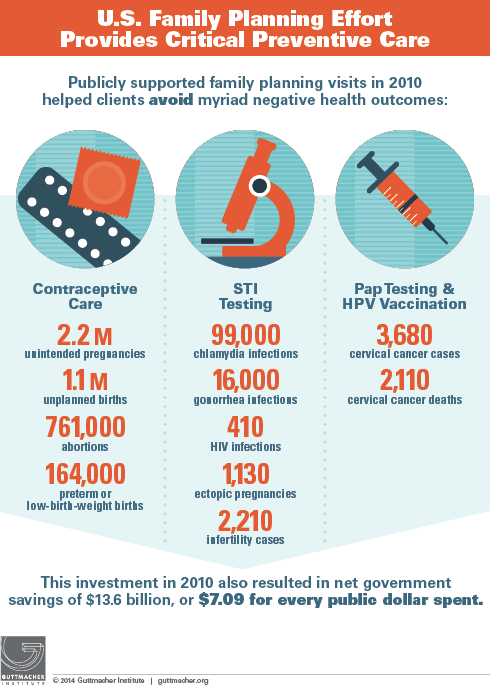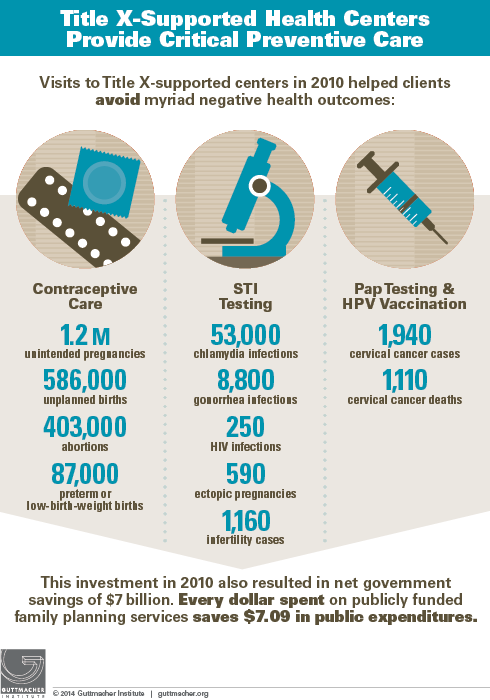U.S. women have long relied on publicly funded family planning services as a critical source of preventive care. A new analysis shows just how vital this care is to ensuring the long-term health of women and their families. According to "Return on Investment: A Fuller Assessment of the Benefits and Cost Savings of the US Publicly Funded Family Planning Program," by Jennifer J. Frost and colleagues, the public investment in family planning services not only helps women and couples avoid unintended pregnancy and abortion, but also helps them avoid cervical cancer, HIV and other STIs, infertility, and preterm and low birth-weight births—all while saving substantial public dollars. Services provided at Title X–supported health centers alone account for more than half the overall benefits.
As the Institute reported previously, contraceptive care provided during publicly supported family planning visits in 2010 helped women prevent an estimated 2.2 million unintended pregnancies, which would have led to 1.1 million unplanned births. This new analysis shows that approximately 288,000 of these births would have been spaced more closely than is medically recommended and 164,000 would have been preterm, low birth weight or both.
Without the STI services provided during family planning visits, an estimated 3.2 million women would have forgone chlamydia or gonorrhea testing, which would have resulted in tens of thousands of undetected and untreated STIs. In 2010, the STI testing provided during publicly supported family planning visits averted an estimated 99,000 cases of chlamydia, 16,000 cases of gonorrhea, 410 cases of HIV, 1,100 ectopic pregnancies and 2,200 cases of infertility.

Absent publicly funded family planning services, some 2.3 million women would have forgone or postponed cervical cancer testing in 2010. As a direct result of the Pap and HPV tests and HPV vaccines provided during publicly supported family planning visits in 2010, an estimated 3,700 cases of cervical cancer and 2,100 cervical cancer deaths were prevented.
"This analysis quantifies, for the first time, many of the myriad benefits of publicly funded family planning services beyond enabling women to prevent unintended pregnancies," says lead author Jennifer Frost. "Millions of women have long looked to publicly funded family planning providers for their basic health care. This study provides the most comprehensive portrait to date of the value of taxpayers’ investment in these services."
In addition to the health benefits resulting from publicly funded family planning services, this investment also resulted in a gross public savings of $15.8 billion: $15.7 billion from enabling women to prevent unplanned pregnancies, $123 million from STI/HIV testing, and $23 million from Pap and HPV testing and HPV vaccines. After subtracting the $2.2 billion in family planning program costs, the services provided in 2010 resulted in net government savings of $13.6 billion, or $7.09 saved for every public dollar spent.
The contraceptive services provided in 2010 by Title X–supported health centers enabled women to avoid 152,000 closely spaced births and 87,000 preterm or low birth-weight deliveries. The other services provided at Title X–supported centers helped women avoid 53,000 chlamydia infections, 8,800 gonorrhea infections, 1,900 cases of cervical cancer and 1,100 cervical cancer deaths.

"This study documents the impact of a wide range of preventive services that are promoted under the Affordable Care Act (ACA) and are offered routinely during family planning visits," says study author Adam Sonfield. "The positive impact of these services is undeniable, and it is our hope that these benefits will continue to grow as the ACA expands access to preventive health services for many more individuals."
It is critical to note that these data were collected prior to the implementation of most elements of the ACA, most notably the law’s expansion of Medicaid. There is every reason to believe that, as more individuals gain insurance coverage, particularly through Medicaid, the number of women served by publicly funded health centers and private doctors under Medicaid will continue to increase, along with the major health benefits that result from access to these services.
"Return on Investment: A Fuller Assessment of the Benefits and Cost Savings of the US Publicly Funded Family Planning Program," by Jennifer J. Frost, Adam Sonfield, Mia R. Zolna and Lawrence B. Finer, is currently available online and will appear in a forthcoming issue of The Milbank Quarterly.
Detailed appendix tables with state-level data are also available online.